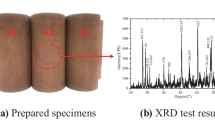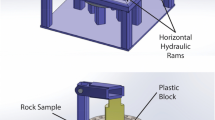Abstract
Triaxial testing is a reliable and popular test method used to obtain key properties of rock and soil used in geotechnical design and numerical modelling. Testing equipment should be sufficiently equipped to accurately simulate the in-situ stress state and hydrogeological conditions of the specific design region. However, detailed information on the specifications and development of versatile triaxial apparatuses for testing rock to a high degree of accuracy has rarely been reported in the literature. This paper describes details of a triaxial apparatus developed for testing intact and jointed rock. The newly developed apparatus is able to obtain information regarding stress-strain behaviour, pore fluid pressure changes, volume changes, permeability and crack development behaviour of the test specimen. Following the description of the triaxial apparatus, results of a series of undrained triaxial tests performed on Hawkesbury sandstone specimens at different confining pressures (i.e. 2, 5, 8, 10, 12, 18 and 25 MPa) and a constant pore water pressure of 1 MPa, are presented. At lower confining pressures the sandstone showed more brittle characteristics and at higher confining pressures (i.e. greater than 18 MPa) it showed a more ductile behaviour. Mohr-Coulomb diagrams showed a decline in friction angle with increasing confining pressure. Maximum induced pore water pressure was increased linearly with increasing initial effective confining pressure. Volumetric strain variations showed a significant dilation at lower confining pressures with a considerable volume increase. Permeability exponentially decreased with increasing confining pressure. Acoustic emission data revealed that crack initiation occurred close to the peak stress for specimens tested at low confining pressures but it occurred at much lower stresses in specimens tested at higher confining pressures.


















Similar content being viewed by others
References
Ranjith PG (2004a) Recent advances in triaxial facilities for soil and rock testing. Electron J Geotech Eng 9(B)
Hoek E, Franklin JA (1968) Simple triaxial cell for field or laboratory testing of rock. Trans Inst Mining Metall, pp A22–A26
Edmond JM, Paterson MS (1972) Volume change during the deformation of rocks at high pressure. Int J Rock Mech Min Sci 9:161–182
Berre T (1982) Triaxial testing at the Norwegian Geotechnical Institute. Geotech Test J 5:3–17
Bro A (1996) A weak rock triaxial cell. Int J Rock Mech Min Sci Geomech Abstr 33(1):71–74
Singh AB (1997) Study of rock fracture by permeability method. J Geotech Geoenviron Engng Div, ASCE 123(7):601–608
Indraratna B, Haque A (1999) Triaxial equipment for measuring the permeability and strength of intact and fractured rocks. Geotechnique 49(4):515–521
Barla G, Barla M, Debernardi D (2010) New triaxial apparatus for rocks. Rock Mech Rock Eng 43:225–230
Indraratna B, Ranjith PG (2001) Laboratory measurement of two-phase flow parameters in rock joints based on high pressure triaxial testing. Geotech Geoenviron Eng, ASCE, pp 918–928
Ranjith PG, Perera MSA (2011) A new triaxial apparatus to study the mechanical and fluid flow aspects of carbon dioxide sequestration in geological formations. Fuel 90(8):2751–9
Taheri A, Tani K (2010) Characterization of a sedimentary soft rock by a small in-situ triaxial test. Geotech Geol Eng 28:241–249
Tani K (1999) Proposal of new in-situ test methods to investigate strength and deformation characteristics of rock masses. In: Proceedings of 2nd international symposium on pre-failure deformation of geomaterials, Torino, Italy
Singh M, Raj A, Singh B (2011) Modified Mohr-Coulomb criterion for non-linear triaxial and polyaxial strength of intact rocks. Int J Rock Mech Min Sci 48:546–555
Ramamurthy T, Arora VK (1994) Strength predictions for jointed rocks in confined and unconfined states. Int J Rock Mech Min Sci & Geomech Abst 31(1):9–22
Lockner DA (1993) The role of acoustic emission in the study of rock fracture. Int J Rock Mech Min Sci Geomech 30:883–899
Ord A, Vardoulakis I, Kajewski R (1991) Shear band formation in Gosford sandstone. Int J Rock Mech Min Sci 28:397–409
Pells PJN (1977) Measurement of engineering properties of Hawkesbury sandstone. Aus Geomach J 3535:10–20
ASTM (2000) American Society for Testing and Materials. Annual book of ASTM standards, vol 04.08, Philadeplhia, PA, USA
Mogi K (1971) Fracture and flow of rocks under high triaxial compression. J Geophys Res 76:1255–1269
Haimson B, Chang C (2000) A new true triaxial cell for testing mechanical properties of rock, and its use to determine rock strength and deformability of Westerly Granite. Int J Rock Mech Min Sci 37:285–296
Schwartz AE (1964) Failure of rock in the triaxial shear test. In: Proceedings of the 6th US rock mechanics symposium, Rolla, Mo, pp 109–135
Yu MH, Zan TY, Zhao J, Yoshimine M (2002) A unified strength criterion for rock material. Int J Rock Mech Min Sci 39:975–989
Singh M, Singh B (2005) A strength criterion based on critical state mechanics for intact rocks. Rock Mech Rock Eng 38(3):243–248
Hoek E, Kaiser PK, Bawden WF (1995) Support of underground excavations in hard rock. Balkema, Rotterdam
Aldrich MJ (1969) Pore pressure effects on Berea Sandstone subjected to experimental deformation. Geol Soc Am Bull 80(8):1577–1586
Green DH, Wang HF (1986) Fluid pressure response to undrained compression in saturated sedimentary rock. Geophysics 51(4):948–956
Goodman RE, Ohnishi Y (1972) Undrained shear testing of jointed rock. Rock Mech 5:129–149
Fredrich JT, Martin JW, Clayton RB (1995) Induced pore pressure response during undrained deformation of tuff and sandstone. Mech Mater 20:95–104
Gowd TN, Rummel F (1980) Effect of confining pressure on the fracture behaviour of a porous rock. Int J Rock Mech Min Sci Geomech Abstr 17:225–22
Rong G, Wang X (2011) Research on hydraulic conductivity of coarse sandstone under triaxial compression. Applied mechanics and materials 94–96:1146–1151
Eid TH (2007) A technique for estimating permeability of a randomly fractured rock mass. Acta Geotech 2:97–102. doi:10.1007/s11440-007-0029-9
Tanikawa W, Shimamoto T (2006) Klinkenberg effect for gas permeability and its comparison to water permeability for porous sedimentary rocks. Hydrol Earth Syst Sci Discuss 3:1315–1338
Perera MSA, Ranjith PG, Choi SK, Airey D (2012) Investigation of temperature effect on permeability of naturally fractured black coal for carbon dioxide movement: An experimental and numerical study. Fuel 94:596–605
Martin C, Chandler N (1994) The progressive fracture of Lac du Bonnet Granite. Int J Rock Mech Min Sci & Geomech Abstr 31(6):643–659
Eberhardt E, Stead D, Stimpson B, Read RS (1998) Identifying crack initiation and propagation thresholds in brittle rock. Can Geotech J 35:222–233
Brodsky NS (1985) An investigation of the fracture of granite under triaxial stress. University microfilms 273
Zhao Y, Huang J, Wang R (1993) Real-time SEM observations of the microfracturing process in rock during a compression test. Int J Rock Mech Min Sci Geomech Abstr. 30:643–652
Pestman BJ, van Munster JG (1997) Microstructural analysis of a uniaxially deformed sandstone – evidence of inter granular micro crack growth. Int J Rock Mech Min Sci 34:3–4, paper No. 245
Park DW, Schuerger MG (1983) Improved monitoring technique for fractures in underground mine openings. Trans Soc Min Eng Am Inst Min, Metall Pet Eng, Inc (AIME) 274:2009–2012
Daniel IM, Rowlands RE (1975) On wave and fracture propagation in rock media. Exp Mech 15(12):449–57
Mark W, Lin AO, Abatan W-MZ (1998) Crack damage detection of structures using distributed electrical-time-domain reflectometry sensors. Proc SPIE 3325:173
Pestman BJ, van Munster JG (1996) An acoustic emission study of damage development and stress-memory effects in sandstone. Int J Rock Mech Min Sci Geomech Abstr 33:585–593
Zang A, Christian FW, Dresen G (1996) Acoustic emission, microstructure, and damage model of dry and wet sandstone stressed to failure. J Geophys Res 101(B8):17507–17521
Ranjith PG, Jasinge D, Song JY, Choi SK (2008) A study of the effect of displacement rate and moisture content on the mechanical properties of concrete: Use of acoustic emission. Int J Mech Mater 40(6):453–469
Ranjith PG, Fourar M, Pong SF, Chian W, Haque A (2004b) Characterization of fractured rocks under uniaxial loading states. Int J Rock Mech Min Sci 41(3), CD-ROM
Author information
Authors and Affiliations
Corresponding author
Rights and permissions
About this article
Cite this article
Wasantha, P.L.P., Darlington, W.J. & Ranjith, P.G. Characterization of Mechanical Behaviour of Saturated Sandstone Using a Newly Developed Triaxial Apparatus. Exp Mech 53, 871–882 (2013). https://doi.org/10.1007/s11340-012-9690-5
Received:
Accepted:
Published:
Issue Date:
DOI: https://doi.org/10.1007/s11340-012-9690-5




